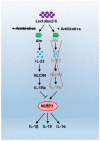The Hidden Cost of Modern Medical Interventions: How Medical Advances Have Shaped the Prevalence of Human Fungal Disease
- PMID: 30987351
- PMCID: PMC6631793
- DOI: 10.3390/pathogens8020045
The Hidden Cost of Modern Medical Interventions: How Medical Advances Have Shaped the Prevalence of Human Fungal Disease
Abstract
Life expectancy in the West is the highest it has ever been, due to the introduction of better hygiene practices and sophisticated medical interventions for cancer, autoimmunity and infectious disease. With these modern advances, a rise in the prevalence of opportunistic infections has also been observed. These include several fungal infections, which present a particular clinical challenge due to the lack of fungal vaccines, limited diagnostics and increasing antifungal drug resistance. This mini-review outlines how modern-day clinical practices have shaped the recent increase in fungal diseases observed in the last few decades. We discuss new research that has implicated the use of immune-modulating drugs in the enhanced susceptibility of vulnerable patients to life-threatening fungal infections.
Keywords: Aspergillus; Candida; antibiotics; corticosteroids; fungi; ibrutinib; macrophage.
Conflict of interest statement
The authors declare no conflicts of interest.
Figures


References
-
- Roser M. Life Expectancy. Published online at OurWorldInData.org . [(accessed on 31 December 2018)]; Available online: https://ourworldindata.org/life-expectancy.
Publication types
Grants and funding
LinkOut - more resources
Full Text Sources

